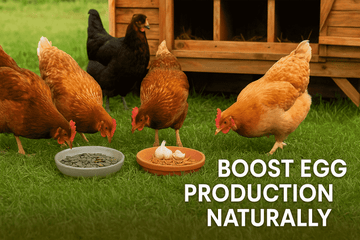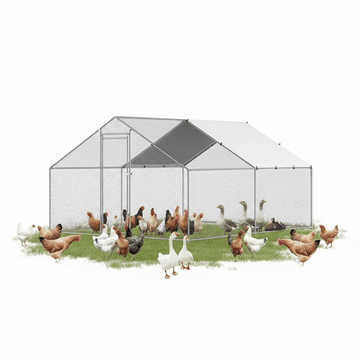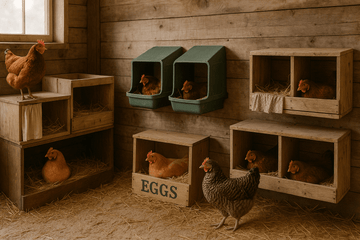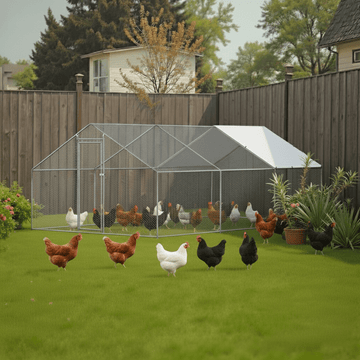Every backyard chicken keeper dreams of gathering a basket full of fresh eggs each morning. But sometimes, no matter how much you care for your hens, egg production slows down or becomes inconsistent. The good news? You don’t need synthetic boosters or factory-style interventions to fix this. There are natural, highly effective ways to enhance your hens’ laying performance—without compromising their health or happiness.
From diet tweaks to environmental adjustments, this guide will walk you through proven strategies to help your flock reach their full egg-laying potential. These secrets are backed by experience, science, and the wisdom of seasoned chicken keepers who swear by natural methods. Let’s crack the code to getting more eggs—naturally.
Understanding Your Hens' Laying Cycle
Factors Affecting Egg Production
Before you can optimize egg production, you need to understand what affects it. Chickens are biological creatures whose laying cycles depend on multiple interconnected factors—age, breed, season, stress, diet, and light exposure.
Young hens (pullets) typically begin laying around 18–22 weeks of age. From there, their production peaks in the first 1–2 years and naturally declines thereafter. If your hen is older than three years, don’t expect daily eggs, even with perfect care.
Illness, molting (when hens shed feathers and pause laying), heat stress, or a sudden change in environment can also disrupt egg production. The laying cycle is tightly regulated by daylight hours and internal hormone rhythms. When something’s off—whether it’s stress, diet, or temperature—egg production can dip or stop altogether.
Peak Laying Periods and Signs
A healthy hen in her prime can lay 5–7 eggs a week, depending on the breed. Look for signs like squatting behavior (a sign of sexual maturity), enlarged and red combs/wattles, and consistent use of nesting boxes.
You might notice a slowdown in egg output during winter, after a molt, or when flock dynamics change. That’s normal—but with the right care, you can significantly lessen these slowdowns and get more eggs year-round.
Nutrition: The Foundation of Egg Laying
Essential Nutrients for Laying Hens
Food is fuel—plain and simple. And for hens, it’s not just about getting enough to eat. It’s about getting the right nutrients to support egg formation, shell strength, and hormone balance.
- Calcium: Essential for strong shells. If your hens aren’t getting enough, they’ll pull it from their bones.
- Protein: The building block of eggs. It supports everything from yolk development to feather health.
- Omega-3s and fats: Improve yolk quality and overall egg nutrition.
- Vitamins A, D, and E: Vital for reproductive health and egg consistency.
Layer feed is a good base, but it’s often not enough—especially for free-ranging or high-producing hens. Natural supplements and treats can make all the difference.
Best Natural Feed Ingredients
Incorporate the following into your flock’s routine to supercharge their laying:
- Mealworms: Protein-packed and irresistible.
- Pumpkin seeds: Good for digestion and a mild natural dewormer.
- Sunflower seeds: Rich in vitamin E and healthy fats.
- Oregano and garlic: Natural antibiotics that boost immunity and reduce disease.
- Flaxseeds: Add omega-3s for better yolk quality.
- Alfalfa: Full of essential vitamins and great for shell strength.
These ingredients not only improve laying but also support hen health and energy, which are critical for consistent performance.
Superfoods That Boost Egg Laying
Garlic, Pumpkin Seeds, and Mealworms
Let’s get into specifics.
- Garlic acts as a natural antibiotic and internal cleanser. It boosts immunity, keeps parasites at bay, and improves blood circulation—all things that contribute to better egg production. Add crushed garlic to their water once a week.
- Pumpkin seeds contain cucurbitacin, a compound known to help expel internal parasites. Less parasite stress means better nutrient absorption and higher laying efficiency.
- Mealworms are loaded with protein and are especially valuable during molting or times of low energy. They stimulate appetite and provide instant fuel for egg-making.
Add these foods gradually, monitoring your hens' behavior and egg output. Too much protein, for instance, can cause kidney strain, so always balance with greens and grains.
Herbs Like Oregano and Parsley
Herbs are the unsung heroes of natural egg production.
- Oregano contains powerful antimicrobials like carvacrol and thymol. It supports respiratory health and gut balance, which are critical for healthy hens.
- Parsley is rich in vitamins A and C, calcium, and iron. It’s excellent for blood health and shell formation.
You can grow these herbs in your garden and toss a handful into their run or mix dried herbs into their feed.
Hydration and Egg Production
Importance of Clean, Fresh Water
Water is often overlooked, but it’s a top priority. Eggs are about 70% water, and if your hens are even slightly dehydrated, egg production can drop instantly.
Chickens need access to cool, clean water 24/7. Dirty or stagnant water discourages drinking, leading to dehydration and decreased laying. In summer, dehydration happens fast. In winter, frozen water means hens go without—both are dangerous to egg production.
Automatic waterers, daily refills, and shaded water stations help ensure your flock stays hydrated.
How Dehydration Impacts Laying
When hens are dehydrated:
- Egg size decreases
- Shell quality weakens
- Laying frequency drops
- Stress levels increase
Make it a habit to check waterers at least twice a day, especially in extreme weather. Adding electrolytes during hot spells or after a stressful event (like moving the coop) can help maintain laying momentum.
Light Exposure and Its Role in Laying
Understanding Photoperiods
One of the most powerful, yet often misunderstood, influences on egg production is light. Chickens are photosensitive animals, and their reproductive hormones are triggered by the amount of light they receive each day. In nature, hens lay the most eggs in spring and early summer when daylight exceeds 14–16 hours per day.
When daylight falls below that threshold, as it does in autumn and winter, their laying instinct slows down or stops entirely. This isn’t a defect—it’s a natural cycle. However, if you want to keep egg production steady year-round, managing light exposure is key.
Natural vs. Supplemental Lighting
Natural daylight is always best, but if you want to extend laying during shorter days, you can safely introduce supplemental lighting. A soft, warm light added to the coop in the early morning or evening can simulate longer days.
Use a timer to create a routine (e.g., lights on at 5 AM, off at sunrise). Never leave lights on 24/7—hens need 8 hours of darkness for rest. LED or low-heat bulbs are ideal, and always ensure the light source is safe and securely installed.
Even with extra lighting, don’t expect full summer output in mid-winter—but it can make a big difference in consistency and total annual egg count.
Ideal Living Conditions for Maximum Laying
Coop Size and Ventilation
A cramped, stuffy coop is a recipe for stress and low egg production. Chickens need at least 4 square feet per bird inside the coop and 10 square feet per bird in an outdoor run. Overcrowding leads to pecking, anxiety, and illness—all of which impact laying.
Ventilation is just as important. A well-ventilated coop helps control humidity, ammonia build-up from droppings, and temperature extremes. Fresh air promotes respiratory health and keeps hens more comfortable, especially during the hot summer or damp winter months.
Install vents high on the walls (above roost level) to allow warm, moist air to escape while preventing direct drafts on the birds.
Cleanliness and Nesting Areas
Clean nesting boxes are crucial for egg production. Hens prefer to lay in dry, dark, and quiet spots. Dirty or smelly boxes discourage laying and increase the risk of egg breakage or contamination.
Change nesting material weekly, and spot-clean daily if needed. Use materials like straw, pine shavings, or commercial nest pads. Keep at least one box for every 3–4 hens, and place them in a low-traffic part of the coop.
If you're looking to upgrade your setup for even better results, explore our chicken nesting box. Designed for durability, hygiene, and hen comfort, these nesting solutions help create the ideal egg-laying environment.
Reduce Stress to Increase Egg Yield
Predator Safety
Nothing stops egg laying faster than fear. Even if predators never breach the coop, their presence alone—raccoons, hawks, dogs—can cause hens to stress out and stop laying. One of the easiest ways to improve safety and peace of mind for both you and your flock is by installing automatic chicken coop doors. These smart doors open and close on a timer or light sensor, ensuring your hens are locked in securely at night and safe from predators without needing manual checks.
Protect your flock with:
- Secure fencing or hardware cloth (not chicken wire)
- Predator-proof latches on doors
- Covered runs for aerial predators
- Motion lights or solar alarms for nighttime safety
When your chickens feel safe, they relax. And relaxed hens lay more eggs.
Managing Flock Dynamics
Flock harmony matters. Aggression, bullying, or a poorly integrated new hen can create stress that lowers production. Always monitor how hens interact and isolate any consistent bullies. Provide multiple feeding and watering stations to reduce competition.
Add visual barriers or perches inside the run to help lower-ranking hens avoid confrontation. A peaceful flock is a productive one, and even minor changes in behavior can have major effects on laying patterns.
Exercise and Free-Range Benefits
Physical Activity and Mental Health
Chickens are curious, active creatures. Giving them space to roam, scratch, peck, and explore isn’t just about entertainment—it directly impacts their health and laying ability. Physical activity improves circulation, reduces obesity, and encourages natural foraging behaviors.
Bored hens are more likely to fight, pluck feathers, or go broody. Active hens stay lean and lay more consistently. Even a small mobile run or rotational grazing system can give them a much-needed change of scenery.
Foraging for Natural Supplements
Free-ranging also allows hens to find natural supplements like insects, seeds, and green plants—all of which contribute to better egg quality. Grass and weeds provide chlorophyll for vibrant yolks, while bugs offer extra protein and calcium.
Don’t have space for free-ranging? No problem. Create a “forage corner” with leafy greens, dirt for dust baths, and enrichment toys like hanging veggies or seed blocks.
Natural Supplements for Better Egg Quality
Apple Cider Vinegar, Sea Kelp, and Probiotics
Some of the best egg-boosting tools come from nature’s medicine cabinet.
- Apple cider vinegar (ACV): Adds healthy bacteria, aids digestion, and boosts immunity. Add 1 tablespoon per gallon of water, 1–2 times a week.
- Sea kelp: Loaded with iodine, trace minerals, and vitamins. It improves yolk quality, shell strength, and overall productivity. Mix into feed at 1–2% of the ration.
- Probiotics: Maintain a healthy gut flora, especially after illness or antibiotics. Use probiotic powders or live-culture yogurt in moderation.
These natural additives help your hens make the most of the food they eat—translating into better eggs without any artificial enhancers.
How Often to Use and In What Quantity
Use supplements wisely. ACV should be cycled in and out—overuse can affect calcium absorption. Kelp should be used sparingly, especially with commercial feeds already rich in minerals.
Watch your hens and adjust based on their energy, appearance, and laying pattern. If you see improvement, stick with it. If you notice odd droppings, poor appetite, or behavior changes, pull back and reassess.
Seasonal Adjustments for Year-Round Laying
Winter Feeding and Lighting
Winter brings shorter days, colder temperatures, and slower egg production. But with the right adjustments, you can keep your hens laying even in the frostiest months.
Feeding Tips:
- Increase calorie intake with scratch grains, sunflower seeds, and warm treats like oatmeal.
- Add extra protein through mealworms or cooked eggs to support energy and egg formation.
- Offer free-choice calcium (e.g., oyster shell) to help with shell strength.
Lighting Tips:
- Use a timer to provide 14–16 hours of total light per day (including natural daylight).
- Install warm, low-wattage LED bulbs safely in the coop.
- Gradually increase light to avoid shocking your flock into laying too soon.
Keep water from freezing with heated bases or regular refills. And remember, winter is a time when hens naturally rest—don’t push them too hard.
Summer Cooling Tips
Heat stress is just as harmful as cold. In summer, hens eat less and drink more, often resulting in smaller or fewer eggs.
To prevent overheating:
- Provide shade and good airflow in the coop.
- Freeze fruits or veggies like watermelon for cooling treats.
- Add electrolytes to water on especially hot days.
- Avoid overcrowding, as body heat builds fast in tight spaces.
Happy, cool hens are productive hens. Watch for signs of heat stress like panting, spreading wings, or listlessness, and act fast to reduce temperatures.
Choosing the Right Breeds for High Yield
Best Layers for Backyard Flocks
Not all chickens are created equal when it comes to egg-laying. Some breeds are designed for daily production, while others are more ornamental or dual-purpose.
Top egg-laying breeds:
- Leghorns: White eggs, 280–300 eggs/year.
- Rhode Island Reds: Brown eggs, hardy and reliable layers.
- Golden Comets: Hybrid layers, known for near-daily eggs.
- Australorps: Calm temperament, consistent brown egg production.
If egg output is your main goal, prioritize these breeds. They’re bred for performance and generally low-maintenance.
Dual-Purpose vs. Layer-Only
Dual-purpose breeds like Orpingtons and Plymouth Rocks give you both eggs and meat. They tend to lay fewer eggs (180–220 per year) but are hardier and great for small homesteads.
Layer-only breeds focus entirely on egg production but may be more sensitive to weather or stress. Your choice depends on your goals—maximum eggs or multi-use birds.
Always source from reputable breeders to ensure you get healthy, well-socialized chicks with strong laying genetics.
Detecting and Solving Laying Problems Early
Sudden Drops in Production
A sudden stop or drop in egg laying can be alarming. But it’s often due to one of these fixable issues:
- Molting: Natural feather loss and regrowth can pause laying for weeks.
- Stress: New flock mates, loud noises, or predators can cause hens to stop.
- Health issues: Internal parasites, egg binding, or reproductive disease.
- Environmental changes: New coop, feed, or lighting routine.
Always start with observation. Check droppings, feathers, comb color, and behavior. Make small adjustments—like improving nutrition, adding light, or giving time to acclimate—and track any changes.
Egg-Eating and Broodiness
Two big problems that hurt egg production:
Egg-eating: Often starts accidentally—an egg breaks, a hen tastes it, and a bad habit forms. Prevent it by:
- Collecting eggs promptly
- Using roll-away nest boxes
- Removing broken eggs immediately
Broodiness: When a hen wants to sit and hatch eggs. She’ll stop laying and stay in the nest. Break the cycle by:
- Removing her from the nest
- Blocking the nesting box at night
- Placing her in a well-lit, cool area away from the coop
Both behaviors are manageable with early detection and consistent intervention.
Record Keeping and Egg Tracking
How Logs Help Spot Patterns
Keeping a record of your flock’s laying habits is one of the best ways to optimize productivity. Track:
- Daily egg count
- Breed and age of layers
- Feed changes
- Weather patterns
- Health events
This allows you to identify which birds are consistent and which might need extra care or culling. It also helps spot early signs of illness or stress before they become bigger issues.
Using Apps or Notebooks
You can go old school with a wall calendar or notebook, or use digital tools like:
- Flockfox
- Henwatch
- Coop Manager
Some apps allow you to track feed usage, medication, and costs—all in one place. Whatever system you choose, consistency is key.
Data gives you insights. Insights help you improve care. And better care leads to more eggs. It’s a simple loop that starts with just jotting things down.
Creating a Routine for Consistent Laying
Feeding Schedule
Chickens are creatures of habit. The more predictable their routine, the more stable their laying becomes. Start with a consistent feeding schedule—ideally twice a day. Provide access to quality layer feed in the morning and again in the evening, supplementing with natural treats or free-ranging during the day.
Stick to scheduled treat times as well. Random or excessive treats can throw off their nutritional balance. Offering grit and oyster shells in separate feeders allows them to self-regulate their calcium and digestion.
Feed your hens before the hottest or coldest parts of the day to encourage better eating and energy use. Routine fuels not just their bodies—but also their biological clocks.
Daily Care Checklist
Creating a daily rhythm helps avoid missed tasks that impact laying. Here’s a simple checklist to follow:
- ✅ Fresh feed and clean water every morning
- ✅ Quick health check—look at combs, eyes, and activity
- ✅ Collect eggs at least twice a day
- ✅ Remove soiled bedding or droppings
- ✅ Lock up securely at night
Weekly tasks might include checking for mites, cleaning feeders and waterers, and refreshing nesting box material. This structure helps you catch issues early, reduce stress for your birds, and build an environment that encourages reliable laying.
Over time, this routine becomes second nature—to both you and your flock.
Conclusion
Getting more eggs from your hens doesn’t require harsh interventions or synthetic boosters. It starts with understanding their natural cycles and supporting them with the right environment, diet, and care. From superfoods and fresh water to predator protection and light exposure, every detail adds up to healthier, happier hens—and better eggs.
By following the natural secrets outlined in this guide, you’re not just chasing productivity—you’re raising birds that thrive. And when your hens are living their best lives, they’ll show it in your egg basket.
Consistency, observation, and a bit of daily love go a long way. Trust the process, stay patient, and enjoy the rewards—one beautiful egg at a time.
FAQs
1. How many hours of light do hens need to lay eggs?
Hens need 14–16 hours of light daily to maintain optimal laying. During shorter days, consider adding safe, supplemental lighting in the coop to maintain productivity.
2. What should I do if my hen stops laying suddenly?
Check for signs of stress, illness, or molting. Evaluate changes in diet, lighting, and predator activity. Restore consistency and nutrition, and the hen will likely resume laying.
3. Can free-ranging chickens lay more eggs?
Yes, free-ranging supports better health and egg quality through access to natural supplements and exercise. However, eggs may be hidden unless nesting boxes are appealing.
4. Is it okay to give kitchen scraps to hens?
In moderation, yes. Avoid anything salty, greasy, moldy, or toxic like avocado skins, chocolate, or raw beans. Stick to vegetables, grains, and fruit peels for safe treats.
5. How can I naturally deworm my laying hens?
Use pumpkin seeds, garlic, and diatomaceous earth as part of their diet. Keep the coop clean and dry, and rotate foraging areas to reduce parasite load.





